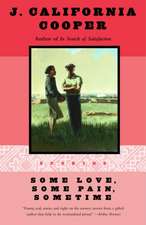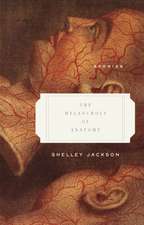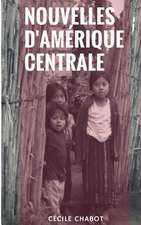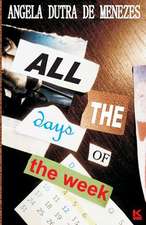Moral Disorder and Other Stories
Autor Margaret Atwooden Limba Engleză Paperback – 31 ian 2008
Preț: 66.52 lei
Nou
Puncte Express: 100
Preț estimativ în valută:
12.73€ • 13.82$ • 10.69£
12.73€ • 13.82$ • 10.69£
Carte disponibilă
Livrare economică 01-15 aprilie
Livrare express 15-21 martie pentru 19.71 lei
Preluare comenzi: 021 569.72.76
Specificații
ISBN-13: 9780385721646
ISBN-10: 0385721641
Pagini: 225
Dimensiuni: 134 x 202 x 18 mm
Greutate: 0.24 kg
Editura: Anchor Books
ISBN-10: 0385721641
Pagini: 225
Dimensiuni: 134 x 202 x 18 mm
Greutate: 0.24 kg
Editura: Anchor Books
Notă biografică
Margaret Atwood's books have been published in over thirty-five countries. She is the author of more than forty books of fiction, poetry, and critical essays. In addition to The Handmaid's Tale, her novels include Cat's Eye -- shortlisted for the Booker Prize -- Alias Grace, which won the Giller Prize in Canada and the Premio Mondello in Italy, The Blind Assassin, winner of the 2000 Booker Prize, and her most recent, Oryx and Crake -- shortlisted for the 2003 Booker Prize. She lives in Toronto with writer Graeme Gibson.
Extras
THE HEADLESS HORSEMANFor Halloween that year — the year my sister was two — I dressed up as the Headless Horseman. Before, I’d only ever been ghosts and fat ladies, both of which were easy: all you needed was a sheet and a lot of talcum powder, or a dress and a hat and some padding. But this year would be the last one I’d ever be able to disguise myself, or so I believed. I was getting too old for it — I was almost finished with being thirteen — and so I felt the urge to make a special effort. Halloween was my best holiday. Why did I like it so much? Perhaps because I could take time off from being myself, or from the impersonation of myself I was finding it increasingly expedient, but also increasingly burdensome, to perform in public. I got the Headless Horseman idea from a story we’d read in school. In the story, the Headless Horseman was a grisly legend and also a joke, and that was the effect I was aiming for. I thought everyone would be familiar with this figure: if I’d studied a thing in school I assumed it was general knowledge. I hadn’t yet discovered that I lived in a sort of transparent balloon, drifting over the world without making much contact with it, and that the people I knew appeared to me at a different angle from the one at which they appeared to themselves; and that the reverse was also true. I was smaller to others, up there in my balloon, than I was to myself. I was also blurrier. I had an image of how the Headless Horseman was supposed to look. He was said to ride around at night with nothing on top of his shoulders but a neck, his head held in one arm, the eyes fixing the horrified viewer in a ghastly glare. I made the head out of papier mâché, using strips of newspaper soaked in a flour-and-water paste I cooked myself, as per the instructions in The Rainy Day Book of Hobbies. Earlier in my life — long ago, at least two years ago — I’d had a wistful desire to make all the things suggested in this book: animals twisted out of pipe cleaners, balsa-wood boats that would whiz around when you dropped cooking oil into a hole in the middle, and a tractor thing put together out of an empty thread spool, two matchsticks, and a rubber band; but somehow I could never find the right materials in our house. Cooking up paste glue was simple, however: all you needed was flour and water. Then you simmered and stirred until the paste was translucent. The lumps didn’t matter, you could squeeze them out later. The glue got quite hard when it was dry, and I realized the next morning that I should have filled the pot with water after using it. My mother always said, “A good cook does her own dishes.” But then, I reflected, glue was not real cooking. The head came out too square. I squashed it at the top to make it more like a head, then left it down by the furnace to dry. The drying took longer than I’d planned, and during the process the nose shrank and the head began to smell funny. I could see that I should have spent more time on the chin, but it was too late to add on to it. When the head was dry enough, at least on the outside, I painted it what I hoped was a flesh colour — a wishy-washy bathrobe pink — and then I painted two very white eyeballs with black pupils. The eyes came out a little crossed, but it couldn’t be helped: I didn’t want to make the eyeballs grey by fooling around with the black pupils on the damp white paint. I added dark circles under the eyes, and black eyebrows, and black enamel hair that appeared to have been slicked down with brilliantine. I painted a red mouth, with a trickle of shiny enamel blood coming down from one corner. I’d taken care to put a neck stub on the bottom of the head, and I painted this red — for where the head had been severed — with a white circle in the middle of the bottom part, for the neck bone. The body of the Horseman took some thought. I made a cape out of a piece of black fabric left over from a now-obsolete puppet stage of mine, gathering it at the neck end — designed to sit on top of my head — and sewing buttons down the front, and cutting two inconspicuous holes at eye level so I’d be able to see out. I borrowed my mother’s jodhpurs and riding boots, left over from before she was married — she hadn’t ridden a horse since her wedding day, she was in the habit of saying, proudly or regretfully. Probably it was both. But I didn’t pay much attention to my mother’s tone of voice, then: I had to tune it out in order to charge full speed ahead with what I myself was doing. The riding boots were too big, but I made up for that with hockey socks. I safety-pinned the jodhpurs around the waist to keep them from falling down. I got hold of some black winter gloves, and improvised a horse whip out of a stick and a piece of leather I’d scrounged from the box of archery materials. Archery had once been popular with my father, and then with my brother; but my father had given it up, and the box had been abandoned in the trunk room in the cellar, now that my brother had to study so much. I tried on the entire outfit in front of my mirror, with the head held in the crook of my arm. I could scarcely see myself through the eyeholes, but the dark shape looming in the glass, with two sinister eyeballs staring out balefully from somewhere near the elbow, looked pretty good to me. On the night itself I groped my way out the door and joined my best friend of the moment, whose name was Annie. Annie had done herself up as Raggedy Ann, complete with a wig of red wool braids. We’d taken flashlights, but Annie had to hold my arm to guide me through the darker patches of the night, which were numerous in the badly lit suburb we were traversing. I should have made the eyeholes bigger. We went from door to door, shouting, “Shell out! Shell out!” and collecting popcorn balls and candy apples and licorice twists, and the Halloween toffees wrapped in orange and black waxed paper with designs of pumpkins and bats on them of which I was especially fond. I loved the sensation of prowling abroad in the darkness — of being unseen, unknown, potentially terrifying, though all the time retaining, underneath, my own harmless, mundane, and dutiful self. There was a full moon, I think; there ought to have been one.The air was crisp; there were fallen leaves; jack-o-lanterns burned on the porches, giving off the exciting odour of singed pumpkin. Everything was as I’d imagined it beforehand, though already I felt it slipping away from me. I was too old, that was the problem. Halloween was for little children. I’d grown beyond it, I was looking down on it from my balloon. Now that I’d arrived at the moment I’d planned for, I couldn’t remember why I’d gone to all that trouble. I was disappointed, too, at the response of the adults who answered the doors. Everyone knew who my friend Annie was portraying — “Raggedy Annie!” they cried with delight, they even got the pun — but to me they said, “And who are you supposed to be?” My cape had a muffling effect, so I often had to repeat the answer twice. “The Headless Horseman.” “The headless what?” Then, “What’s that you’re holding?” they would go on to say. “It’s the head. Of the Headless Horseman.” “Oh yes, I see.” The head would then be admired, though in the overdone way adults had of admiring a thing when they secretly thought it was inept and laughable. It didn’t occur to me that if I’d wanted my costume to be understood immediately I should have chosen something more obvious. However, there was one member of the audience who’d been suitably impressed. It was my little sister, who hadn’t yet gone to bed when I’d made my way through the living room en route to the door. She’d taken one look at the shambling black torso and the big boots and the shiny-haired, frowning, bodiless head, and had begun to scream. She’d screamed and screamed, and hadn’t been reassured when I’d lifted up the cape to show that it was really only me underneath. If anything, that had made it worse. Do you remember the head?” I ask my sister. We’re in her rackety car, driving over to see our mother, who is now very old, and bedridden, and blind. My sister doesn’t ask, “What head?” She knows what head. “It looked like a pimp,” she says. “With that greaser hair.” Then she says, “Smart move, Fred.” She talks out loud to other, inferior drivers when she’s driving, a thing she does adroitly. All of the other drivers are named Fred, even the women. “How do you know what a pimp looks like?” “You know what I mean.” “A dead pimp, then,” I say. “Not completely dead. The eyes followed you around the room like those 3-D Jesuses.” “They couldn’t have. They were sort of crossed.” “They did, though. I was afraid of it.” “You played with it, later,” I say. “When you were older. You used to make it talk.” “I was afraid of it anyway,” she says. “That’s right, Fred, take the whole road.” “Maybe I warped you in childhood,” I say. “Something did,” she says, and laughs. For a while after that Halloween, the head lived in the trunk room, which contained not only two steamer trunks filled with things of my mother’s from her previous life — tea cloths she’d embroidered for her trousseau, long kid gloves she’d saved — but also a number of empty suitcases, and the metal box of fly-tying equipment, and the archery materials, and an assortment of miscellaneous items I used to rummage through and pilfer. The head was on an upper shelf, the one with the battered skates and the leather boots — my father’s, also my mother’s. Foot, foot, foot, foot, head, foot, foot, foot — if you weren’t ready for this arrangement and happened to glance up at it, the effect could be disconcerting. By that time we had a second phone in the house so I could talk with my boyfriends, or go through what passed for talking, without exasperating my father too much — he thought phone conversations should be short, and should convey information. The door to the trunk room was right beside the phone. I liked to keep that door closed while I was talking; otherwise I could see the head staring out at me through the gloom, blood dribbling from the corner of its mouth.With its sleek black hair and minimal chin, it looked like a comic-book head waiter who’d got into a fight. At the same time it seemed malignantly attentive, as if it was taking in every word I said and putting a sour construction on my motives. After its period of retreat in the trunk room, the head migrated into my sister’s dress-up box. By now, I was fifteen and my sister was four. She was still an anxious child — if anything, she was more anxious than ever. She didn’t sleep through the night — she’d wake up five or six or seven or nine or ten or eleven times, according to my mother. Although I had the room right next to hers, I never heard her plaintive calls and frightened wailing. I slept through it all as if drugged. But sleeping mothers hear the cries of their own children, we’ve been told. They can’t help it. Studies have been done. My mother was no exception: she’d hear the little voice calling to her across the blankness of sleep, she’d half wake, then stumble into my sister’s room, soothe her mechanically, bring her drinks of water, tuck her in again, then go back to bed and fall asleep, only to be wakened once more and then once more and then once more. She’d grown thinner and thinner in the last four years, her skin pale, her hair brittle and greying, her eyes unnaturally large. In actuality, she’d caught a disease of the thyroid from the hamster we’d foisted on my sister as a pet in the vain hope that the sound of it creaking round and around on its exercise wheel at night would be calming to her. It was this disease that accounted for my mother’s scrawniness and staring eyes: once diagnosed, it was easily cured. But that detail tended to get sidelined during the later recountings of this story, both by my mother and by me. The fairy child, the changeling who didn’t follow the convenient patterns of other children, who sucked up its mother’s energy in an uncanny and nocturnal manner — this is a theme with more inherent interest to it than a hamster-transmitted thyroid disease.My sister did look a little like a fairy changeling. She was tiny, with blond braids and big blue eyes, and a rabbity way of nibbling on her lower lip as if to keep it from trembling. Her approach to life was tentative. New foods made her nervous, new people, new experiences: she stood at the edge of them, extended a finger, touched gingerly, then more often than not turned away. No was a word she learned early. At children’s parties she was reluctant to join in the games; birthday cake made her throw up. She was particularly apprehensive about doors, and about who might come through them. Thus it was probably a bad idea of my father’s to pretend to be a bear, a game that had been a great success with his two older children. My sister was fascinated by this game as well, but her interest took a different form. She didn’t understand that the bear game was supposed to be fun — that it was an excuse for laughing, shrieking, and running away. Instead, she wanted to observe the bear without being spotted by it herself. This was the reason she’d snipped two holes at eye level in my mother’s floor-to-ceiling drapes. She’d go in behind the drapes and peek out through the holes, waiting in a state of paralyzed terror for my father to come home. Would he be a bear, or would he be a father? And even if he looked like a father, would he turn into a bear without warning? She could never be sure.
From the Hardcover edition.
From the Hardcover edition.
Recenzii
“Sharply focused, intensely personal. . . . Moral Disorder is domestic realism at its most convincing. . . . These are poignant stories crammed with richly nostalgic detail, rueful, wise, elegiac.” —Joyce Carol Oates, The New York Review of Books“Elegant. . . . In Moral Disorder, Atwood travels deep into the expanse of memories and language built up over her writing lifetime and offers a handful of gems to illuminate our times.” —The Los Angeles Times Book Review“Poignant. . . . Wry. . . . The tremendous imaginative power of [Atwood's] fiction allows us to believe that anything is possible.” —New York Times Book Review“Searingly intelligent. . . . [These are] beguiling narratives that Atwood unspools with signature grace and incisiveness.” —Elle
Descriere
In these ten interrelated stories, Atwood traces the course of a life and also the lives intertwined with it. By turns funny, tragic, earthy, and deeply personal, "Moral Disorder" displays Atwoods celebrated storytelling gifts and unmistakable style to their best advantage.














